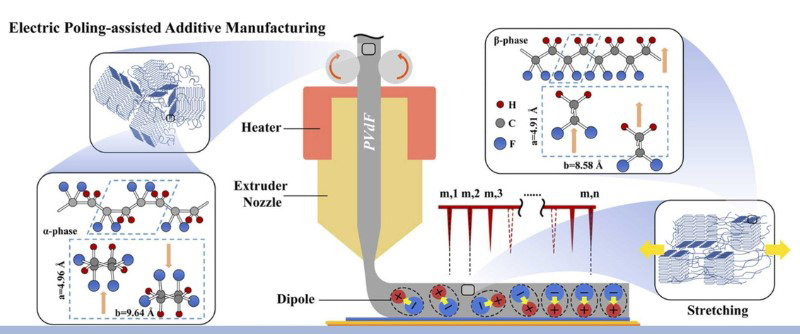
Purdue University researchers have combined 3D printing and electric poling into a single process called electric poling-assisted additive manufacturing, or EPAM. It aligns the dipoles in PVdf filament during the printing, which leads to a better indication of the stress being applied. (Purdue University image/Robert Nawrocki)
Method creates parts with customized shapes and sensor properties
WEST LAFAYETTE, Ind. – Manufacturers of smart medical devices, smart robots and other products with smart sensors could simplify their device design and fabrication using a patent-pending Purdue University method that combines piezoelectric poling of filament and 3D printing in a single process.
Traditional sensor materials have piezoelectric properties that make them suitable to create smart sensors. Applying stress in one direction produces voltage in another direction. Although these materials measure how much stress is applied, which is among the basic properties of sensors, they cannot be used in 3D printing.
3D printing, also known as additive manufacturing, has several advantages over traditional manufacturing, including customizing parts' shapes and geometries beyond planar options. However, the polyvinylidene difluoride (PVdf) filament used in 3D printing doesn't have strong piezoelectric properties. Its dipoles are randomly oriented, which produces less voltage. As a result, traditional PVdf filament isn't a good indicator of stress, and electric poling must be conducted in a post-processing treatment, increasing time and cost.
Purdue researchers in the Purdue Polytechnic Institute have combined 3D printing and electric poling into a single process called electric poling-assisted additive manufacturing, or EPAM. It aligns the dipoles in PVdf filament during the print, which leads to a better indication of stress that is being applied. This allows 3D-printed parts to have both strong sensing abilities and customized shapes. Importantly, it saves time and money.
Robert Nawrocki, assistant professor in the School of Engineering Technology in the Purdue Polytechnic Institute, said the EPAM process accomplishes stretching and poling simultaneously, which are necessary conditions for the polarization.
"During the EPAM process, stretching the molten PVdF rod rearranges the amorphous strands in the film plane, and the applied electric field aligns dipoles toward the same direction," Nawrocki said. "The EPAM process can print free-form PVdF structures and induce the formation of β-phase, which is primarily responsible for the piezoelectric response."
Jose M. Garcia-Bravo and Brittany Newell, associate professors of in the School of Engineering Technology, Nawrocki and PhD candidate Jinsheng Fan successfully printed PVdf force sensors with a fused deposition modeling 3D printer with a corona electric poling setup.
"The piezoelectric activity, measured in picocoulombs per newton, or pC/N, was calculated based on the piezoelectric output voltage," Nawrocki said. "The average piezoelectric activity of EPAM-printed PVdF films was 47.76 pC/N, or about five times higher than unpoled 3D-printed films, at 9.0 pC/N. The piezoelectric activity of unpoled 3D-printed PVdF films indicated that 3D printing in the absence of an electric field did not result in dipole alignment."
Nawrocki disclosed the innovation to the Purdue Research Foundation Office of Technology Commercialization, which has applied for patent protection on the intellectual property. Industry partners interested in further developing the technology should contact Dhananjay Sewak






